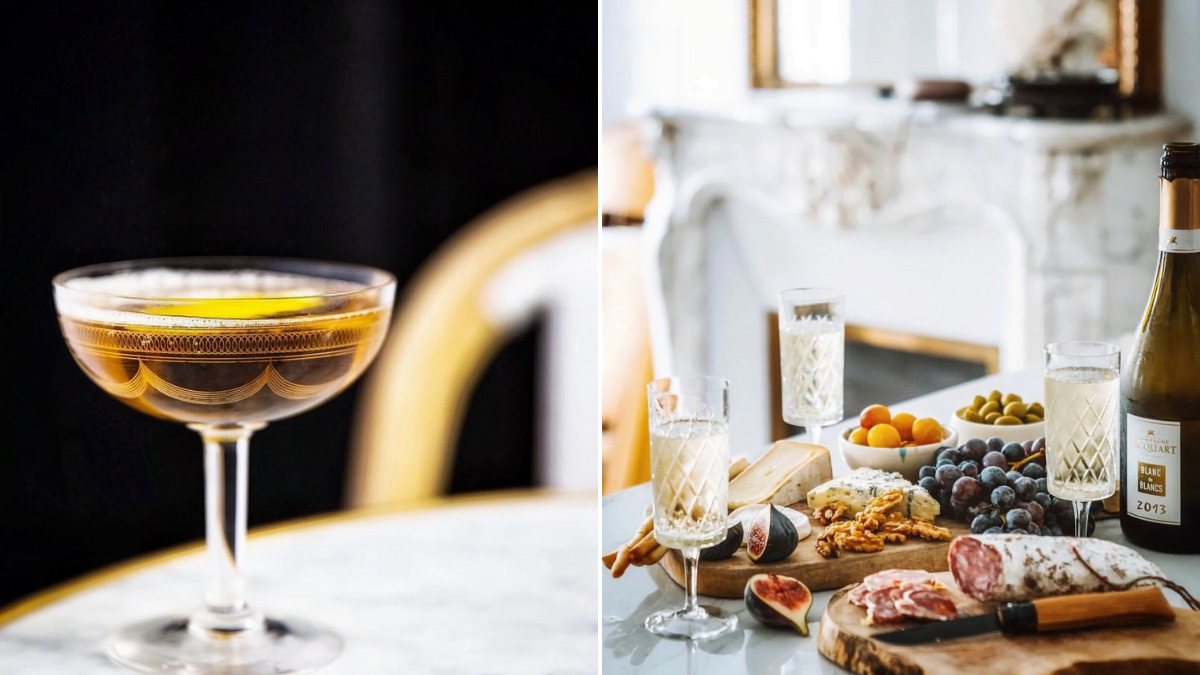Here is your guide to hosting the perfect French apéritif! In France, the traditional apéritif is a cultural ritual and a brilliant French custom that you can adopt everywhere! The French apéritif is a pre-dinner drink, a moment of sharing —with family or friends—, and preparing your palate for the meal to follow. It’s not just about the food and drink (though those are certainly important) but it’s about taking a moment to reset and appreciate life. The French apéritif is just another opportunity to enjoy the French way of life. You’ll be surrounded by friends, with great food and a nice drink.
It isn’t traditional to have this with every meal but more when sharing with friends and family —either at home or at a restaurant. An apéritif is also called an apéro for short in France. “Apéro” is a familiar term in French, so prefer to say “apéritif” instead.
Do you want to know more about the French apéritif? Here’s your guide to the perfect French apéritif. In this article, you’ll learn the history of the French apéritif, the optimum time for apéro, how to prepare your table, what types of drinks and foods to serve, and what to bring to a French apéritif. Here’s everything you need to know to create the perfect French apéritif at home.
1. A Brief History Of The French Apéritif
In French, the word apéritif comes from the Latin verb “aperire”, meaning “to open.” The apéritif was introduced in France in 1846 when a French chemist, Joseph Dubonnet, created his eponymous wine-based drink as a means of delivering malaria-fighting quinine. The medicine was a bitter brew, so he developed a formula of herbs and spices to mask quinine’s sharp flavor, and it worked so well that the recipe has remained well-guarded ever since. French Foreign Legion soldiers made use of it in mosquito-infested Northern Africa. Dubonnet’s wife was so fond of the drink that she had all her friends try it, and its popularity spread. The popularity of apéritifs in Europe crossed the Atlantic and by 1900, they were also commonly served in the United States.
2. L’Heure De l’Apéritif
In Paris, l’apéritif usually happens in the early evening, from around 6:00 pm through 9:00 pm—depending on dinner time. The idea is to stimulate the appetite, but not ruin dinner. And sometimes the apéro doubles as dinner (a.k.a. “apéritif dînatoire”, an aperitif dinner.) An apéro can be an hour or three hours, there are no time constraints.
During the week, apéritifs can be something spontaneous with co-workers at the end of a working day. An apéritif is also possible before lunch, especially on weekends. People like to enjoy pre-lunch apéritifs around 12 – 12.30 pm.
3. How To Prepare Your Table
L’apéritif is a no-fuss kind of get-together, which means that you don’t have to set a fancy table. However, the French have perfected “l’Art de la table” —the art of the table— for generations. And even the most casual French apéritif can be adorned with fine silverware, crystal glasses, and porcelain plates. French apéritif tables are always beautifully set, and also very simple to put together.
You could, for example, arrange slices of cheeses on this , or create a cheese board on this . Add some marinated olives and nuts to this beautiful and place crudités in this . If you cook any salty cakes or desserts, you can cut some slices and arrange them on this . Depending on the types of drinks you’re serving, you can put some , , and . Finally, add these to your table, and don’t forget ! To help you set your table, I’ve found some items that will help you create the perfect French apéritif. Shop my picks below!
Dinnerware & Flatware
Serving Plates & Cheese Boards
Glassware
Table Linens
4. What To Drink For A French Apéritif
Apéritif drinks usually contain alcohol, so let us suggest drinking in moderation. When we speak of French apéritif, you can enjoy pretty much any drink, but there are some essential French drinks for an apéritif in France. Also, traditional French apéro drinks are lightly alcoholic, as the goal is to tease the taste buds—not to get too tipsy.
Before starting the apéritif, it is common to toast with everybody (beware that crossing glasses when toasting in a group is considered bad luck) looking into their eyes while saying: “Santé!”
Wine
French wine is always a good idea for a French apéritif! You can opt for a dry, light white wine like a Chablis, Graves, or Touraine. If you prefer red wines, get a light one like a Bourgogne or something light-bodied like a Beaujolais. In summer, whites and rosé tend to replace the reds. Just make sure your white and rosé are served cold (as they should be).
Champagne
In France, Champagne is usually an aperitif drink reserved for special occasions (birthdays, weddings, Christmas dinner, etc.) or to celebrate an event.
Kir And Kir Royale
Kir, also called Blanc-cassis, is a common and very popular apéritif-cocktail made with a measure of crème de cassis (blackcurrant liqueur) topped up with white wine like bourgogne aligoté. Mix the crème with Champagne and you have a Kir Royale!
Pastis
In the South of France, the apéritif drink of choice is the anise-flavored spirit called pastis, which is enjoyed mixed with water or a few ice cubes. Created in the early 1900s in response to the ban on absinthe, this sweet, anise-based liqueur is flavored with fennel and coriander. The proper ratio is one part pastis to five parts water. Some French tinge theirs red with grenadine for a tomate, or green with mint syrup for a perroquet.
Lillet
Sweet and subtly bitter, wine-based Lillet comes in three varieties: blanc, rouge, and rosé. All are lightly fruity blends of Bordeaux wine and brandy macerated with a combination of fruits, barks, and peels, and all make for an ideal aperitif on the rocks with a twist. This drink is immortalized in Ian Fleming’s Casino Royale when James Bond ordered a barman to make a Vesper Martini.
Suze
Suze is a classic French apéritif created in 1885. This vegetal, herbal, bright yellow liqueur gets its bitterness from gentian root, a plant grown in the mountainous regions of France and Switzerland. Cut its bitterness with tonic or soda water before drinking it as the French do: over ice with a wedge of lemon.
Pineau Des Charentes
Pineau des Charentes is a regional aperitif of western France, made in the départements of Charente, Charente-Maritime, and (to a lesser extent) Dordogne. It is a fortified wine (mistelle or vin de liqueur), made from either fresh, unfermented grape juice or a blend of lightly fermented grape must to which a Cognac eau-de-vie is added and then matured. One of my favorite French apéritif drinks!
Byrrh
Pronounced “beer”, this red wine-based aperitif is loaded with warming spices and relies on quinine for lightly bitter undertones. Created in 1866 it is refreshing and slightly nutty. Think of it as slightly spicier sweet vermouth and you can drink it straight with a large cube of ice.
Dubonnet
Dubonnet is a sweet, aromatized wine-based aperitif. Joseph Dubonnet created his namesake apéro in Paris in 1846. White Dubonnet is a dry white wine infused with herbs, while the red is sweet, flavored with spices and quinine. The beverage is famous in the UK for being the favorite drink of Her Majesty the Queen, and it was the favorite drink of Queen Elizabeth The Queen Mother as well.
5. What To Eat For A French Apéritif
An apéritif may be served with some hors d’oeuvres or amuse-bouches. Opt for foods that are easily shared as most apéritifs involving picking from an assortment of nibbles spread out across a table. Remember that this is a time for sharing in general, whether it be food and drinks or stories from your day or week. And because the typical French apéritif is a prelude to a good meal, you should not eat too much apéritif food. Here are below some essential French foods for an apéritif in France.
Cheeses
You cannot go wrong with a good French cheese selection. I recommend some camembert, tomme de Savoie, Comté, chèvre or Fourme d’Ambert. Try to pick various types of cheeses that range from soft to hard and cow to goat to sheep. And remember to always take your cheeses out of the fridge about an hour before serving for best results. Don’t forget some crusty bread —see the French baguette recipe.
Charcuterie
Opt for Jambon de pays, saucisson, viande de grison and other dried meats. You could also add in a pâté, rillettes or terrine.
Spreads & Veggies
The French like fresh bites, veggies, and salty things like olives, cherry tomatoes, carrot sticks, melon, cornichons, and nuts. You can opt for spreads like tapenade, hummus, tzatziki, and eggplant dip (“caviar d’aubergines”). If you want to go really French, pick up some radishes to eat with salted butter and bread.
6. L’Apéritif Dînatoire (Apéro Dînatoire)
An apéritif dînatoire or apéro dînatoire is an apéritif that involves more than just light snacks, and it usually replaces a proper dinner. It can either be planned —you can decide to invite some friends at home or meet them in a bar for an apéro dînatoire— or something more spontaneous. For example, a simple French apéritif lasting longer than usual can quickly evolve to an apéritif dînatoire. Typical foods for an apéritif dînatoire are cheese plates, charcuterie, bread, with salads. You can also prepare in advance some crudités, and make quiches, pissaladières, marinated olives, or salty cakes.
7. What To Bring To A French Apéritif
If you’re invited to someone’s place for an apéritif, it’s always a good idea to bring something. Prefer to bring something sophisticated and avoid cheap beer and crisps. If the host says to bring food, try to shop locally at a bakery, butcher, or épicerie. You could bring a tapenade or some rillettes with fresh bread — a pain de campagne or a pain aux céréales—, some cheeses or a saucisson from the market. In terms of drinks, you can bring a good bottle of wine or any type of apéritif you would like to drink.
As with all invitations, tell your hosts as soon as you accept the invitation if you don’t eat certain foods so they can be prepared. Not telling them and then not eating what they have prepared is considered extremely rude in France.
8. Recipe Books For Your French Apéritif
- Apéritif: Cocktail Hour the French Way: A Recipe Book
- Drinking French: The Iconic Cocktails, Apéritifs, and Café Traditions of France
- A Table: Recipes for Cooking and Eating the French Way
- La Buvette: Recipes and Wine Notes from Paris
- How to Drink French Fluently: A Guide to Joie de Vivre with St-Germain Cocktails
Et voilà! I hope you enjoyed my guide to hosting the perfect French apéritif! It doesn’t take much to enjoy a French apéritif: good friends, great food, a nice drink, and an expanse of time before you. If you have any questions, please add your comment below.
Disclaimer: I carefully select and personally love every product featured on Leonce Chenal. If you buy through my links, I may earn an affiliate commission at no extra cost to you. Merci for your support <3




